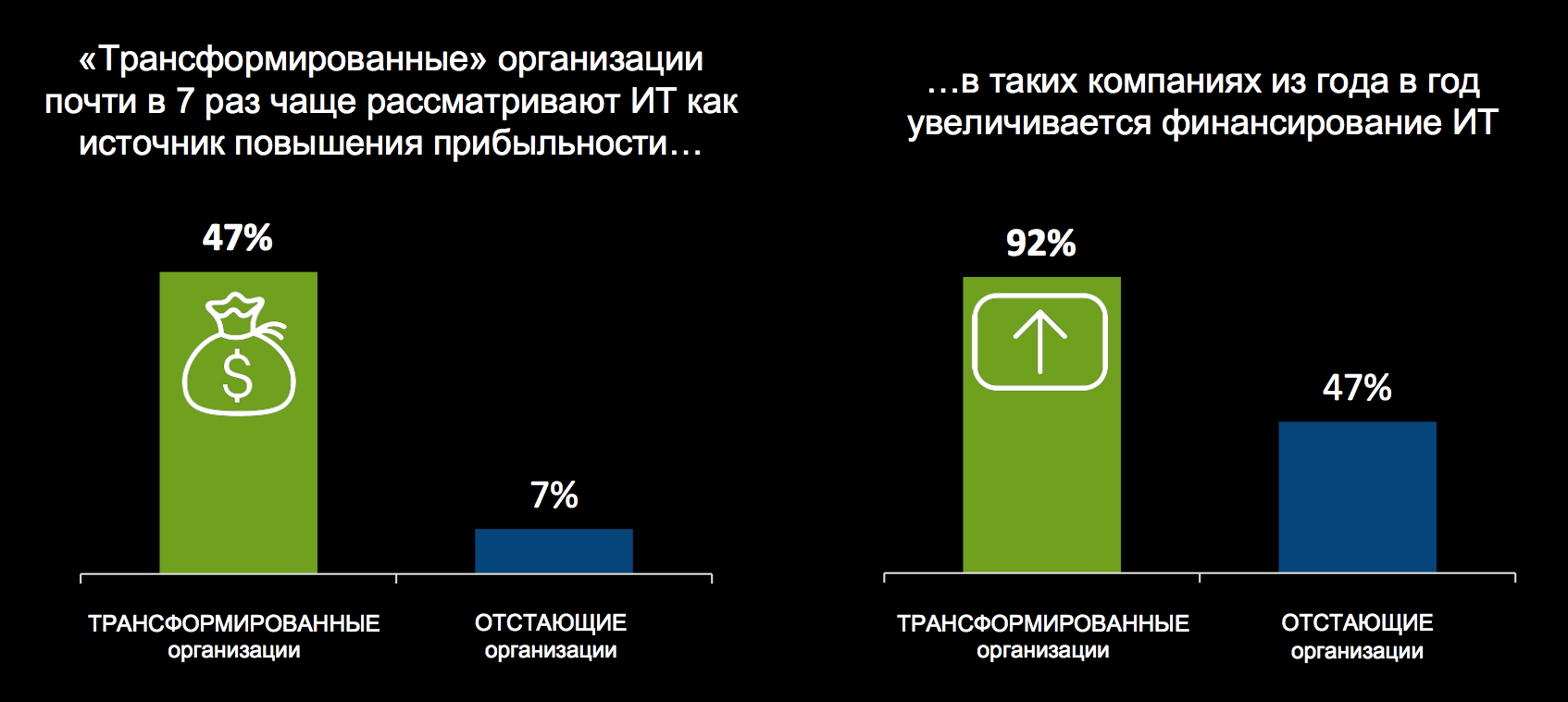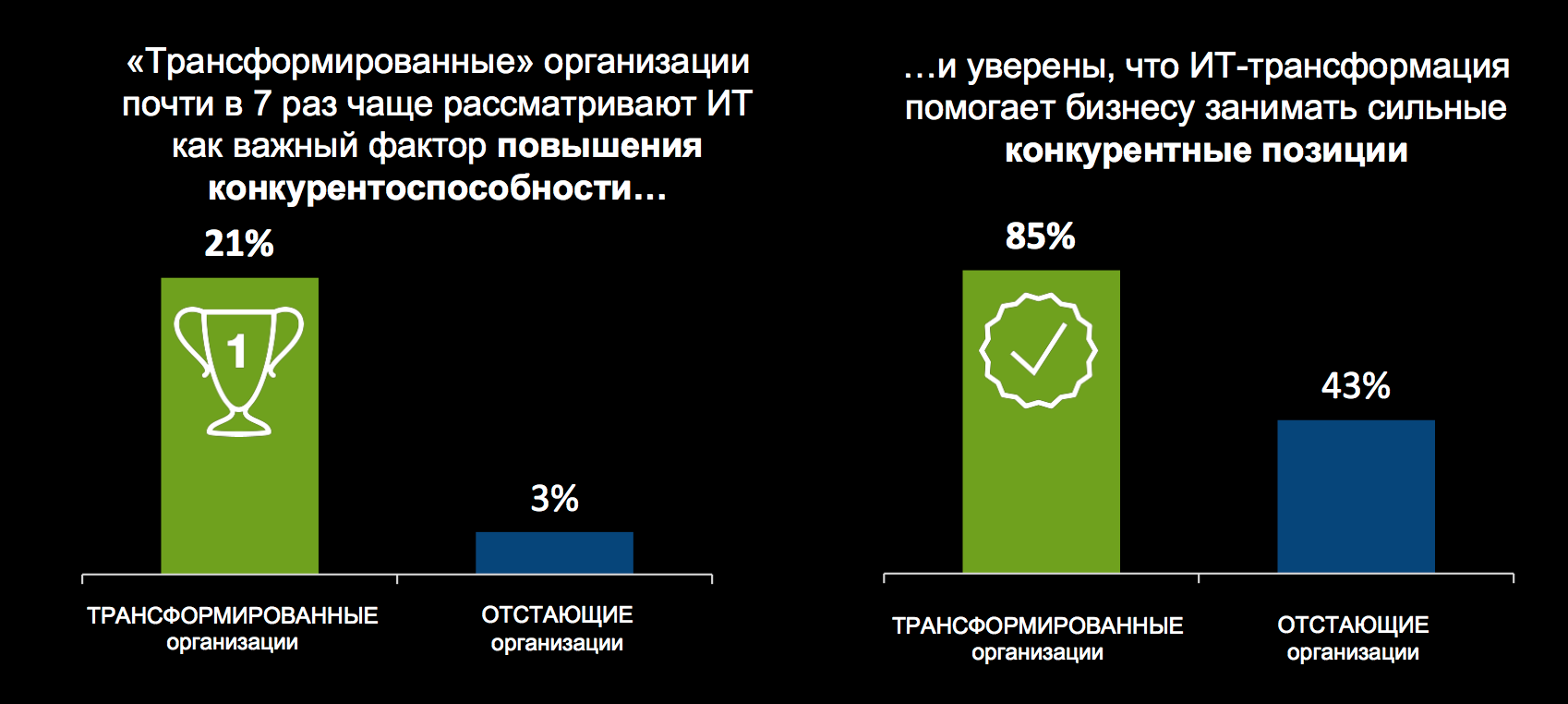Dell EMC Announces ESG 2017 IT Transformation Maturity Curve Survey Results
- 71% of companies recognize that IT transformation is necessary to achieve competitiveness.
- 95% of respondents do not use IT transformation to achieve their business goals.
- “Transformed” organizations are seven times more likely to recognize IT as a determining factor for increasing profits and increasing competitiveness.
- Last year, 96% of “transformed” organizations exceeded their revenue targets, and they are twice as likely to get ahead of these targets.

Dell EMC Announces New ESG 2017 IT Transformation Maturity Curve study by Enterprise Strategy Group (ESG). The survey of IT directors and managers of large companies in different countries revealed that the majority of respondents are confident that their organizations do not yet fully use various aspects of IT transformation in order to remain competitive in an increasingly digital world.
Organizations face the challenge of transforming legacy IT systems and technologies, and digital transformation becomes the driving force. However, as demonstrated by this study commissioned by the Dell EMC, 95 percent of respondents claim that their organizations risk falling behind a small group of companies that are already transforming their IT infrastructures, processes and methods of delivering products / solutions / services in order to accelerate the transformation into "Digital enterprise".
Many organizations still measure the application life cycle in months, if not in years; have a fragmented, non-integrated infrastructure; they continue to struggle with the problems of inherited architecture - that is, they face all the obstacles that are characteristic of those who are striving for a successful digital transformation.
')
“These results reflect a situation where the vast majority of customers say that they need to optimize their existing infrastructure to take advantage of the digital era,” said David Goulden, President, EMC Dell. “Nevertheless, the survey shows that the majority of respondents are lagging behind the“ elite ”- a small group of competitors who managed to“ crack the code ”of the IT transformation, which allowed them to successfully compete in the market. By investing in IT transformation, organizations are able to overcome the contradictions between legacy IT and new digital technologies in order to ultimately achieve their goals, accelerate product entry into the market and increase competitiveness. ”
The ESG 2017 IT Transformation Maturity Curve study was conducted to understand the role of IT transformation in the development of digital business. The study used a specially developed model of maturity to identify the various stages of development of IT transformation and find out to what extent global organizations have reached these stages. The results of the study are based on the respondents' answers about the local IT infrastructure of their organizations, about the implemented processes and organizational changes.
The survey of managers of one thousand organizations from different countries revealed four stages of maturity they achieved in the field of IT transformation:
- Stage 1 - “Laggards” (12%). Organizations at this stage are lagging behind in many, if not all, of the results of the IT transformation assessment in the ESG study.
- Stage 2 - “Beginners” (42%). Organizations are showing progress in IT transformation, but with minimal implementation of modern data center technologies.
- Stage 3 - “Developing” (41%). Organizations demonstrate a commitment to IT transformation and show the average level of deployment of modern data center technologies and IT service delivery methods.
- Stage 4 - “Transformed” (5%). The most advanced organizations in the field of IT transformation.
Most respondents (71%) agree that IT transformation is necessary to maintain business competitiveness. 85% of the “transformed” companies believe that their organizations are in a “very strong” or “strong” position to compete and succeed in their market over the next few years, in contrast to 43% of the least mature companies.

“Transformed” organizations report the greatest progress in using IT resources to accelerate innovation and bring products to market; in the field of automation of previously executed manually processes and tasks; using IT as a source of profit, not cost. These companies are:
- exceeded revenue targets last year (96%), more than twice ahead of less mature competitors;
- eight times more likely than the least mature organizations to report a high degree of collaboration between IT and business units;
- achieve “good progress” (seven times more likely than less mature ones), since IT is their source of profit, not cost;
- they are seven times more likely than less mature organizations; I view IT as an important factor in increasing business competitiveness;
- use IT resources to accelerate innovation, promote and bring products to the market (six times more than the least mature organizations).
According to the ESG study, the introduction of modern data center technologies, such as scalable data storage systems and convergent / hyperconvergent infrastructure, can increase the flexibility and speed of infrastructure deployment, IT projects, and application development. The study showed:
- 54% of respondents use converged or hyper-convergent infrastructure to support applications;
- 58% of respondents implemented scalable storage systems to one degree or another;
- Approximately 50% of respondents adhere to a software-defined approach in the long term and have already begun to implement, evaluate, or plan software-defined technologies.
According to ESG, the introduction of modern IT processes, such as self-service capabilities, IT management through a public cloud type, or the use of DevOps methodologies, can be signs of a successfully transformed company. The study demonstrated the following:
- 26% of respondents have “broad” or “well-established” self-service capabilities;
- 65% of respondents have made “excellent” or “acceptable” progress in providing end users with the same opportunities to provide IT resources as they can get from a provider of public cloud services;
- 43% of respondents claim a "broad" or "good" implementation of the principles and best practices of DevOps.
IT transformation is often correlated with a closer and more effective relationship between IT and business units, which was confirmed by research. His results showed:
- 36% of IT organizations (and the results of their activities) are evaluated by the management or the board of directors on a monthly basis, and 38% - on a quarterly basis;
- 39% of organizations have a leading IT manager in their staff who report directly to the CEO;
- 61% of the least mature organizations indicate that their shareholders view IT as a “permanent service provider, but ultimately as a source of costs”.
At the Dell EMC World conference in May 2017, experts will look at IT transformation issues and talk about how they allow organizations to achieve their goals on the path to digital transformation.
Quotes
John McKnight, Vice President, Research and Analysis Services, Enterprise Strategy Group
“Today, companies are increasingly relying on technology to grow and improve all aspects of their business. Nonetheless, the ESG study found that admittedly fully “transformed” IT organizations are still rare. The good news is that as you progress along the “maturity curve”, you can get all the new benefits, and this can be achieved by following the example of “transformed” organizations. ”
Adam DeMattia, Research Director, Enterprise Strategy Group
“Inherited IT is largely unprepared for the new demands of the digital business: the application life cycle is measured in months, and even years; fragmented, non-integrated infrastructure does not allow organizations to get a complete picture of their data; performance bottlenecks occur that affect the end-user experience at different sites that require constant availability and low response times; inflexible IT architectures force organizations to make major upgrades with the slightest change in business requirements, and traditional resource allocation processes are such that information technology is often seen as an obstacle, not as a means for business development. Organizations must eliminate this conflict between the goals of digital transformation and today's reality, otherwise the business will not achieve its ultimate goals. ”
About the ESG 2017 IT Transformation Maturity Curve study
The study was conducted by the Enterprise Strategy Group from December 9, 2016 to January 5, 2017, commissioned by Dell EMC based on an online survey of one thousand IT directors, managers and employees from the USA, Brazil, Britain, France, China, Japan and Australia. Respondents are familiar with the current state of their organizations, the planned IT budget and costs; they are involved in the procurement of infrastructure solutions by their organizations. Respondents presented large enterprises from various industries.
Additional resources (in English):
- Take the test for assessing the maturity of an IT transformation ;
- Check out the full text of the ESG IT Transformation Maturity Curve study;
- Dell EMC Blog: 1,000 IT Practitioners Answer: Where Are We with IT Transformation?
- Dell EMC Services Blog: Defeating Digital Disruption Through IT Transformation
About Dell EMC
Dell EMC , a member of the Dell Technologies group of companies, helps organizations modernize, automate and transform data processing centers, delivering industry-leading converged infrastructure solutions, servers, storage systems and data protection technologies. This provides a solid foundation for transforming IT based on hybrid cloud technologies and transforming business processes with cloud-based applications and big data solutions. Dell EMC offers customers, including 98 percent of Fortune 500 companies, the broadest portfolio of innovative solutions covering the entire IT infrastructure: from client systems to data centers and the cloud.
Dell EMC World
We invite you to the Dell EMC World conference, which will be held May 8-11, 2017 in Las Vegas. This is a leading event of the Dell Technologies group of companies that brings together technology and business professionals to share ideas and create a better future together. Learn more at www.dellemcworld.com and follow the #DellEMCWorld hashtag on Twitter.
Source: https://habr.com/ru/post/327844/
All Articles